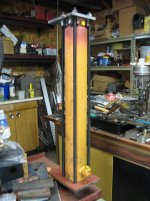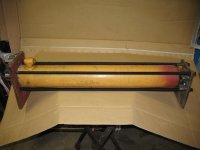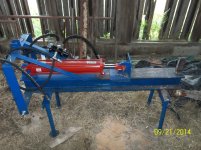I think you might run short of Hbeam considering your chosen length of cylinder. A 24" stroke cylinder retracted length is about 35inches. Add to that your stroke, you are at 59inches. You will need room on the hbeam to make mounting points for cylinder at the rear and also more room for either the wedge or the pusher block, depending on which design you go with. If the wedge is 6" long, you are now at 65 inches, not counting the thickness of the material. That leaves you about 7inches to play with. You will have to design your mounting points for the cylinder carefully or you could end up running short of Hbeam. Since you havent found a cylinder yet, you might look for one with trunnion mounts on the side of the cylinder which would allow you to use a much shorter hbeam
Oil tank capacity is usually at least equal to pump capacity, 1gal of oil for one gal of flow. Thin tall tanks work better than short fat tanks for keeping the oil cool. 2 stage pumps are low flow at high pressure and low pressure at high flow, the 8 or 10 gal capacity tank suggested should work fine, for homeowner splitting since the machine isnt being pushed hard day after day, but if you plan on doing a lot of splitting, go with a larger tank, it will save you long term in wear on the pump and valves.
You also need to plan on a return oil filter, I suggest a 10micron 25gpm filter, but some folks think a 25micron is all you need. I also like using a suction filter just to keep dirt and trash out of the pump. Some say since the return oil is being filtered, suction filter isnt necessary, but I like clean oil running thru my pumps, not clean oil after the pump
If you are thinking about adding a log lift to your splitter, consider purchasing a multi spool valve for the splitting and lifting functions. Most log splitting valves donot have a power beyond feature which is something you must have if you plan on adding or using another control valve for other functions, ie. the log lift. You can get around the power beyond, but it would mean finding a selector valve to switch between functions, more hoses, fitting, and will probably cost more than just buying a 2 spool valve, not to mention the aggravation of having to always switch the selector valve when you want to split or lift.



